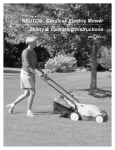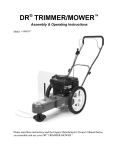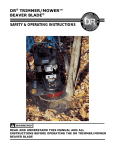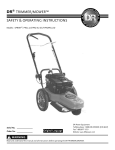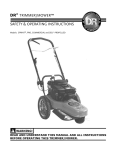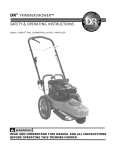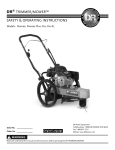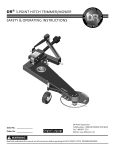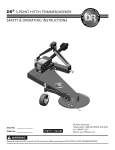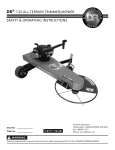Download Weed Eater 176840 Operating instructions
Transcript
DR TRIMMER/MOWER Safety & Operating Instructions Models: SPRINT, PRO, and COMMERCIAL COUNTRY HOME PRODUCTS, INC. www.dr-owner.com $5.00 Congratulations on your purchase of a new DR TRIMMER/MOWER We have done our utmost to ensure that your DR will be one of the most trouble-free and satisfying pieces of equipment you’ve ever owned. Please let us know if you have any questions or problems. We want to answer or correct them quickly. (When you do call or write, please have your serial number and/or order number handy; it will speed things up.) We also hope to hear from you about how you like your new machine. Please tell your friends about your new DR TRIMMER/MOWER . Having new owners spread the word about our products and the way we conduct business is the best advertising we have and it’s the best way we can provide you with even better service in the years to come. Thanks once again! for all of us at Country Home Products, Inc. COPYRIGHT 2002 Country Home Products, Inc. All rights reserved. DOCUMENTATION Written by: Ann Zuccardy, Page Designs Inc. Country Home Products, Inc. Meigs Road P.O. Box 25 Vergennes, VT 05491 Toll-free phone: 1-800-DR-OWNER (376-9637) Fax: 1-802-877-1213 Web site: www.dr-owner.com E-mail: [email protected] Table of Contents Chapter 1: Introducing the DR Trimmer/Mower ........................................................... 1 About This Manual.....................................................................................................................1 Chapter 2: Safety Considerations.................................................................................... 3 Preparing to Use the DR TRIMMER/MOWER..........................................................................3 Safety Information Labels ..........................................................................................................3 Protecting Yourself ....................................................................................................................5 Operating the Machine Safely ....................................................................................................5 Safety with Gasoline-Powered Machines....................................................................................6 A Note to All California and Washington State Users ..................................................................6 Chapter 3: Setting Up Your DR TRIMMER/MOWER ..................................................... 7 DR TRIMMER/MOWER Package Checklist ............................................................................7 DR TRIMMER/MOWER Controls and Features.......................................................................8 Connecting the Battery Wire (Electric-Starting Models Only) .......................................................9 Adding Oil and Gasoline .......................................................................................................... 10 Adjusting the Handlebar........................................................................................................... 11 Adjusting the PTA Lever ......................................................................................................... 12 Chapter 4: Operating Your DR TRIMMER/MOWER .................................................... 13 Electric-Starting....................................................................................................................... 13 Manual-Starting....................................................................................................................... 13 Stopping the Engine ................................................................................................................ 14 Engaging the Trimmer Head .................................................................................................... 14 Stopping the Cords from Spinning............................................................................................ 14 Using PTA (Parallel Trimming Action)...................................................................................... 15 Your Machine’s Cutting Cords.................................................................................................. 17 Adjusting the Cutting Height..................................................................................................... 20 The Mow Ball Support ............................................................................................................ 20 Obstacle Tips .......................................................................................................................... 21 Chapter 5: Maintaining the DR TRIMMER/MOWER .................................................... 24 Regular Maintenance............................................................................................................... 24 Battery Care (For Electric-Starting Models Only)....................................................................... 25 Connecting a Battery Charger.................................................................................................. 25 Removing and Reinstalling the Mow-Ball Support Assembly.................................................... 26 Reassembling the Mow-Ball Support Assembly....................................................................... 27 Removing the Stone Guard Flap .............................................................................................. 28 Removing and Replacing the Bottom Shield............................................................................. 28 Removing and Replacing the Belt ............................................................................................ 29 Adjusting the Belt Tension Through the Trimmer Control Cable................................................. 30 Removing and Replacing the Side Shield................................................................................. 31 Removing the Wheels.............................................................................................................. 32 Chapter 6: Troubleshooting and Warranty .................................................................... 33 Troubleshooting Table ............................................................................................................. 33 ® ™ DR TRIMMER/MOWER Safety & Operating Instructions iii iv ® ™ DR TRIMMER/MOWER Safety & Operating Instructions Chapter 1: Introducing the DR TRIMMER/MOWER Thank you for the purchase of your new DR TRIMMER/MOWER . Over 500,000 people have chosen the DR TRIMMER/MOWER since 1987 to help make property care faster and easier than ever before. This manual is shipped with DR TRIMMER/MOWER SPRINT , PRO, and COMMERCIAL models. It will help you set up and safely operate your new DR TRIMMER/MOWER . Careful adherence to the safety and operating instructions in this manual will ensure many years of productive use. Please let us know if you have any questions or problems by contacting us via e-mail or our toll-free phone number. Our contact information is listed inside the front cover of this manual. When you call or write, please have your serial number or order number available so we can help you quickly. About This Manual This manual is broken down into six main chapters: Chapter 1: Introducing the DR TRIMMER/MOWER ■ Explains the organization of this manual. ■ Provides contact information for Country Home Products, Inc. Chapter 2: Safety Considerations ■ Explains guidelines for safe operation of your machine. Chapter 3: Setting Up Your DR TRIMMER/MOWER ■ Provides instructions for setting up and using your machine after shipment. Chapter 4: Operating Your DR TRIMMER/MOWER ■ Provides instructions for starting and stopping the machine’s engine. ■ Explains the many cutting and trimming features of your machine. ■ Provides tips for dealing with obstacles. Chapter 5: Maintaining the DR TRIMMER/MOWER ■ Provides machine maintenance tips. Chapter 6: Troubleshooting and Warranty ■ Lists common problems and their solutions. ■ Explains how to contact Country Home Products, Inc. should you need further assistance. ■ Provides warranty information. In addition to these chapters, there is a section at the end of this manual for your notes as well as a checklist of daily maintenance procedures on the back cover which will keep your trimmer performing well for years to come. ® ™ DR TRIMMER/MOWER Safety & Operating Instructions 1 Conventions used in this manual WARNING! The exclamation point within an equilateral triangle alerts you to essential operating, safety, and maintenance (servicing) Important! This information is important in the proper use of your machine. Failure to follow this instruction could result in injury to you or damage to your trimmer. Tip: This is a helpful hint to guide you in getting the most out of your trimmer. Tools needed: This indicates you will need a special tool to perform a maintenance function on your machine. Note: This information may be is helpful to you. If you are ever unsure about an action you are about to take, contact Country Home Product’s toll-free support at 1-800-DR-OWNER (376-9637). 2 ® ™ DR TRIMMER/MOWER Safety & Operating Instructions Chapter 2: Safety Considerations Taking the time to read and observe all safety instructions will ensure many years of productive use from your DR TRIMMER/MOWER and help you avoid injury. Please take a few moments to read the following guidelines for safely operating your new machine. Preparing to Use the DR TRIMMER/MOWER ■ Read these Safety and Operating Instructions and the engine manufacturer’s owner’s manual before you use the DR TRIMMER/MOWER . ■ Inspect the area in which you will be working. Look for rocks, sticks, rope, wire, garden tools, etc. and remove these objects before trimming or mowing. Mowing over these objects could damage the machine and cause injury. Safety Information Labels Take some time to become familiar with the following standard safety cautions applicable to your trimmer. Replace damaged or missing safety labels immediately. (#148231) Read the Safety and Operating Instructions. Do not operate the machine near people or animals. Remove all objects that could be thrown by the trimmer line. Always wear safety glasses or goggles while operating the machine. Keep body parts away from the trimmer line. Use caution operating the machine on slopes. Make sure you add oil before starting the engine; the unit is shipped without oil. Fill the oil reservoir slowly to make sure you don’t overfill it. (#127811) A warning notice about the danger inherent in the spinning cords. (#144761; SPRINT model only) ® ™ DR TRIMMER/MOWER Safety & Operating Instructions 3 To avoid injury, keep your hand and feet away from the spinning cords. (#136491) Yet another warning notice for your safety. (#148221; PRO and COMMERCIAL models only) ) In the parallel trimming action (PTA mode, the trimmer’s wheels stay straight while the trimmer head tilts , causing the cords to extend beyond the wheelbase. (#153071) The bail bar is an important safety feature: release it to immediately stop the engine. (#153081) This notice is a handy reminder of your equipment’s name and how you can contact us. (#148241; PRO and COMMERCIAL models only) This label reminds you about the importance of reading and understanding the Safety & Operating Instructions manual and of paying attention to the safety warnings. (#142671; SPRINT model only) 4 ® ™ DR TRIMMER/MOWER Safety & Operating Instructions Protecting Yourself ■ Always wear the protective goggles while mowing to protect your eyes from possible thrown objects. Goggles are provided with your DR TRIMMER/MOWER . Wear shoes with non-slip treads when using your DR TRIMMER/MOWER . If you have safety shoes, we recommend wearing them. Do not use the machine while barefoot or wearing open sandals. Wear long pants while trimming or mowing. Avoid wearing loose clothing or jewelry which might be caught on the mower’s moving parts. Use earmuffs or earplugs to protect your hearing. ■ ■ ■ ■ Operating the Machine Safely WARNING! The items listed in this section will help you keep your DR TRIMMER/MOWER running smoothly and, most importantly, prevent injury to yourself or others. Please review them carefully before starting your machine. ■ ■ ■ ■ ■ ■ ■ ■ ■ ■ ■ Only use the DR TRIMMER/MOWER for trimming and mowing grass, weeds, and other growth as specified in this manual. Use only manufacturer-recommended replacement parts and accessories. Never bend, cut, fit, weld, or alter the DR TRIMMER/MOWER in any way. Modifications to your machine could cause personal injuries and property damage and may void your warranty. ALWAYS shut off the engine and remove the spark plug wire before adjusting the machine. If you have to stop to remove grass or debris from the underside of the deck, ALWAYS disconnect the spark plug wire first. The exhaust area on the engine becomes very hot with use. Allow the engine to cool before doing maintenance or making adjustments. When operating over uneven terrain and slopes, use EXTREME CAUTION to ensure solid and firm footing. Use extra caution when mowing in wet or slippery conditions. ™ The tips of the cutting cords on the DR TRIMMER/MOWER can throw sticks, small stones, gravel, and bits of debris over long distances at great velocity. Do not travel over loose materials such as gravel or mulch with the trimmer head spinning. Doing so could cause personal injury or property damage from thrown objects. Turn off the engine whenever you are not operating the machine. Never leave the engine running when refueling, changing cords, checking, cleaning or working on the machine. Never allow children or animals near the work area. Keep at least 50 feet clear of bystanders and always turn the machine off when someone approaches. Never allow children or people who are unfamiliar with these instructions to use the DR TRIMMER/MOWER . DR® TRIMMER/MOWER™ Safety & Operating Instructions 5 ■ ■ ■ ■ ■ Be cautious when using your DR TRIMMER/MOWER around fencing, wires, ropes, and hoses. It is possible that these and other debris can become wound around the line plates of the machine, potentially damaging the bearings or injuring you. Use the machine only in daylight or good artificial light. Never operate the machine with a damaged shield or without the shield in place. Do not operate the machine when under the influence of alcohol or medication. Watch for traffic when mowing near roadways. Safety with Gasoline-Powered Machines WARNING! The items listed in this section will help you keep your DR TRIMMER/MOWER running smoothly and, most importantly, prevent injury to yourself or others. Please review them carefully before starting your machine. ■ ■ ■ ■ ■ ■ ■ ■ Do not run the engine in an enclosed area or without proper ventilation. Store all fuel in containers specifically designed for this purpose. Plastic containers are more likely to prevent sediment and condensation problems. Refuel your trimmer outdoors only. Do not smoke while refueling or operating the machine. If you spill gasoline, do not attempt to start the engine. Move the machine away from the area of the spill and avoid creating any source of ignition until the gas vapors have dissipated. Wipe up any spilled fuel to prevent a fire hazard and properly dispose of the waste. Allow the engine to cool completely before storing in any enclosure. Never store the machine near an open flame or spark with gas in the tank. Do not change the engine governor settings or modify the engine speed. Some state and local regulations require the use of a spark arrester on gasoline-powered engines. Contact your local fire marshal or forest service for specific information pertaining to your area. If you are required to use a spark arrester, please contact one of our Customer Service Representatives at 1-800-DR-OWNER (376-9637) who will assist you in obtaining and installing one. A Note to All California and Washington State Users California and Washington state laws and the local regulations of some other states prohibit you from operating an internal combustion engine using hydrocarbon fuels without an engine spark arrester. All DR TRIMMER/MOWERS shipped to California and Washington state are shipped with spark arresters. Failure of the owner or operator to maintain this equipment in compliance with state regulations is a misdemeanor under California law and may be in violation of other state and/or federal regulations. Contact your local fire marshal or forest service for specific information in your state. 6 ® ™ DR TRIMMER/MOWER Safety & Operating Instructions Chapter 3: Setting Up Your DR TRIMMER/MOWER This chapter outlines a few simple steps you will need to follow to set up your new machine before you use it. It may be helpful to familiarize yourself with the controls and features on your trimmer by reviewing the picture in the next section before beginning the steps outlined in this chapter. DR TRIMMER/MOWER Package Checklist Country Home Products ships the following items with your new machine. Please check to make sure you have everything listed below: ■ 2 keys (for electric models only). The key is attached to the trimmer just below the bail bar spring. ■ 1 pair of goggles ■ 1 metal head locking tool ■ 1 bundle of light trimmer cord ■ 1 bundle of heavy trimmer cord Note: Remove and discard the plastic shipping caps from the ends of the wheel nuts on your new machine before using it. If you are missing any of the items listed above, please call Customer Service at: 1-800-DR-OWNER (376-9637) for assistance. Country Home Products, Inc. reserves the right to discontinue, change, and improve its products at any time without notice or obligation to the purchaser. The descriptions and specifications contained in this manual were in effect at printing. Equipment described within this manual may be optional. Some illustrations may not be applicable to your machine. DR® TRIMMER/MOWER™ Safety & Operating Instructions 7 DR TRIMMER/MOWER Controls and Features Note: The model shown in Figure 1 may look slightly different from your machine. Keys (Electric models only) Figure 1 8 ® ™ DR TRIMMER/MOWER Safety & Operating Instructions Connecting the Battery Wire (Electric-Starting Models Only) We ship all electric-starting trimmers with the negative terminal battery wire disconnected. This prevents the battery from discharging during shipment. Before using your trimmer, you must connect the battery wire. 1. Connect the wire by pushing the plastic connector onto the negative (–) terminal as shown in Figure 2. Figure 2 DR® TRIMMER/MOWER™ Safety & Operating Instructions 9 Adding Oil and Gasoline WARNING! You must add oil before starting the engine. This machine is shipped without oil. Traces of oil may be in the reservoir from factory testing, but you must add oil before starting the engine. Fill the reservoir slowly checking the dipstick frequently to avoid overfilling. Use approximately 15 ounces of SAE 30 high detergent oil. Important! To get an accurate reading when checking the oil level: ⇒ The machine should be on a level surface. ⇒ The dipstick should be screwed down on Briggs and Stratton engines. ⇒ The dipstick should NOT be screwed down on Kawasaki engines. Tip: To avoid confusion, we recommend leaving the caps on the fuel and oil fills until you are ready to pour either gasoline or oil into the correct fill. Tools needed: You will need approximately 15 ounces of SAE 30 high detergent oil. Use only SAE 30 high detergent oil. Other types of oil could cause problems operating your machine. Please refer to your engine manufacturer’s owner’s manual for detailed oil information. 1. Add 15 ounces of SAE 30 high detergent oil and wait one minute for the oil to settle. (Figure 3) 2. Check the dipstick and continue adding a few ounces of oil at a time, rechecking the dipstick until the oil reaches the fill mark. Be careful not to overfill. 3. Fill the gas tank to within ¼ inch of the top with fresh, unleaded gas. See your engine manufacturer’s owner’s manual for more information. Figure 3 10 ® ™ DR TRIMMER/MOWER Safety & Operating Instructions Adjusting the Handlebar WARNING! Before performing any maintenance procedure, stop the engine and disconnect the spark plug wire. It is important to find a handlebar height that allows the Mow-Ball Support to glide along the ground and remain balanced so you don’t have having to push down or pull up on the handlebar. At the proper height, your hands should rest at a comfortable level and the front end of the trimmer should roll easily on the Mow-Ball Support as shown in Figure 13 on page 20. You may find you like different handlebar heights for different mowing conditions. There are two ways to adjust the height of the handlebar outlined in the following steps: 1. Loosen both the adjustment knobs and move the handlebar up or down until the adjustment is the same on both sides. Use the notches on the adjusters (Figure 4) to measure how many teeth you’ve moved away from the center. When you’ve found a comfortable height, tighten the adjustment knobs securely. 2. For additional height adjustment options, there are two holes in the upper and lower handlebars where the adjustment knobs are located. Most people start with the handlebars set in the lower holes of both the upper and lower handlebar. You can adjust the height up or down by removing the adjustment knob assembly and repositioning the handlebars to a higher or lower hole. Be sure the notches in the two adjusters line up when you reassemble them. (Figure 4) Figure 4 DR® TRIMMER/MOWER™ Safety & Operating Instructions 11 Adjusting the PTA Lever WARNING! Before performing any maintenance procedure, stop the engine and disconnect the spark plug wire. It is easy to adjust the PTA feature. If you’ve moved the handlebar up or down, the PTA (Parallel Trimming Action) lever may need to be adjusted. When the PTA feature is properly engaged there should be just a little slack in the cable. For more information on PTA , please read the section called Using PTA (Parallel Trimming Action) on page 15. 1. Loosen the knob on the PTA . (Figure 5). 2. Move the assembly up the handlebar to tighten the cable or down the handlebar to loosen it. Figure 5 12 ® ™ DR TRIMMER/MOWER Safety & Operating Instructions Chapter 4: Operating Your DR TRIMMER/MOWER This chapter covers the procedures for starting and stopping your new DR TRIMMER/ MOWER and discusses basic operation features. You may find it helpful to review the DR TRIMMER/MOWER Controls and Features picture (Figure 1) on page 8 before reading this chapter. Electric-Starting Note: Use the following steps with electric-starting models only. 1. Push the throttle lever on the right side of the handlebar (see trimmer picture, Figure 1, on page 8) all the way forward to the START position. 2. If your model has a primer, prime the engine. Push the primer bulb in (see trimmer picture, Figure 1, on page 8) for three seconds and completely release it, letting it pop back to its original position. Repeat three to four times. Note: Priming is usually not necessary when restarting a warm engine. In cool weather, you may need to repeat priming. 3. Turn the key (see trimmer picture, Figure 1, on page 8) to the START position until the engine starts, then release. The key will snap back to the RUN position and the engine will continue to run. Manual-Starting Note: You may use this starting method with both manual and electric-starting models. 1. Push the throttle lever on the right side of the handlebar (see trimmer picture on page 8) all the way forward to the START position. 2. If your model has a primer, prime the engine. Push the primer bulb in (see trimmer picture on page 8) for three seconds and completely release it, letting it pop back to its original position. Repeat three to four times. Note: Priming is usually not necessary when restarting a warm engine. In cool weather, you may need to repeat priming. 3. Grasp the recoil starter handle and slowly pull until you feel resistance. Let the cord retract a little bit, then pull the cord rapidly to start the engine. One or two pulls . usually starts the DR TRIMMER/MOWER It may be necessary to repeat priming if the machine does not start within two pulls. DR® TRIMMER/MOWER™ Safety & Operating Instructions 13 Stopping the Engine Note: If you have an electric-starting model, please note that the key does not stop the engine. You must follow these instructions for both electric and manual-starting models. 1. Move the throttle lever back to the STOP position. 2. The key has a pressure lock that prevents it from vibrating loose during operation. If you wish to remove the key, push it in and then quickly and firmly pull it out. If the key becomes difficult to remove, spray FLUID FILM or a similar lubricant into the keyhole. Engaging the Trimmer Head 1. Bring the bail bar toward you and grip it together with the handlebar. (See trimmer picture on page 8.) Keep holding the bail bar to the handlebar. The cutting cords will rotate and will continue to rotate until you release the bail bar. Stopping the Cords from Spinning 1. Release the bail bar from the handlebar. The trimmer head will stop spinning while the engine continues to run. 14 ® ™ DR TRIMMER/MOWER Safety & Operating Instructions Using PTA (Parallel Trimming Action) Your trimmer’s PTA feature moves the machine in a straight line while the trimmer head is both pivoted and tilted to the left for better access to fence lines and other obstacles. PTA allows you to trim in difficult areas without having to pull the machine back and forth. The following two sections explain how to engage PTA and how to return your trimmer to . flat and forward mode (normal operation) after using PTA WARNING! Use caution when edging along gravel paths and driveways. Flying debris can cause serious damage. Important! When using PTA , you should install the cutting cords in one of the bottom four line plates only. Using the upper line plates may cause the cords to hit the wheel. For more information, see Your Machine’s Cutting Cords on page 16. Note: In PTA mode, the trimmer’s wheels stay straight while trimmer head tilts as shown in Figure 6. The cutting cords extend beyond the wheelbase in the PTA mode, allowing you to easily cut under obstacles. The trimmer head and the cutting cords also tilt slightly in PTA mode so you can edge and trim along gardens, paths, and driveways. When using PTA along garden edges, fences, and buildings, we recommend making your first past with the DR TRIMMER/ MOWER in the regular mowing position, staying 4 to 8 inches from the obstacle. Then return for another pass with the machine in PTA mode. Figure 6 DR® TRIMMER/MOWER™ Safety & Operating Instructions 15 Engaging the PTA 1. Pull the PTA lever (Figure 7) against the handlebar and hold it there. This unlocks the axle (Figure 8). 2. Push down on the handlebar to tip the nose of the machine a few inches off the ground. Balancing the weight of the machine on the wheels makes it easier to pivot the front of the trimmer to the left. 3. While continuing to hold the PTA lever down, grip the sides of the handlebar pulling up with the right hand and pushing down with the left, swinging the front of the trimmer to the left. 4. Release the PTA lever. This will lock the axle in PTA mode (Figure 8). Figure 7 Returning to Flat and Forward Mode 1. Pull the PTA lever (Figure 7) against the handlebar and hold it there. 2. Push down on the handlebar to tip the nose of the machine up a few inches off the ground. 3. While continuing to hold the PTA lever down, grip the sides of the handlebar pulling up with the left hand and pushing down with the right, swinging the front of the trimmer to the right, stopping at center. 4. Release the PTA lever. This locks the axle in flat and forward mode. 16 Figure 8 ® ™ DR TRIMMER/MOWER Safety & Operating Instructions Your Machine’s Cutting Cords WARNING! Always turn the engine off when installing or changing cutting cords. Important! Running the trimmer with only one cord installed, or cords installed at other than 180 degrees can cause excessive vibration and may damage the machine. The following figures (Figures 9 and 10) illustrate how the cords are installed on the line plates. These figures show the line plates from a cross section point of view. It may look complicated, but once you’ve done it a couple of times, it’s easy. There are two sets of installation points on each line plate, 180 degrees apart. One set of holes is for larger cord (155 mil) and is marked with large arrows. The other set of holes accommodates smaller cord (130 mil) and is marked with small arrows. Always install two cords opposite each other for the best performance. Figure 9 Figure 10 DR® TRIMMER/MOWER™ Safety & Operating Instructions 17 Installing Cords The standard cord installation method is shown in Figures 11–13. Your trimmer is shipped from the factory with the cords installed in this manner. Important! When using PTA (Parallel Trimming Action), install the cutting cords in one of the bottom four line plates. Installing the cutting cords on the upper line plates can cause the cord to hit the wheel. For i f ti i PTA™ U i PTA™ 10 Note: After you install the cords and before trimming, engage the cutting head with the engine running and spin new cords for a few seconds so they pull tight and are set. 1. Insert the ends of the cords into the openings in the line plate, as shown in Figures 11 and 12. There are different sized arrows at the insertion points to indicate what size cords fit the holes. Figure 11 2. Push the cord through until it comes out the center hole in the line plate as shown in Figure 12. You may also reference Figures 9 and 10 for a cross sectional look at installing the cords. Adjust the cords so the tips are even. 3. Pull the cords through the loop and push the loop up into the line plate groove above them, as shown in Figure 13. The larger cord exits through the larger opening and the smaller cord through the smaller opening. Pull the cords tight. Figure 12 Figure 13 18 ® ™ DR TRIMMER/MOWER Safety & Operating Instructions Cord Tips : We ship two thicknesses of cutting cord with your DR TRIMMER/MOWER heavy-duty (130 mil) and extra heavy-duty (155 mil). Because conditions and vegetation vary so much, you should experiment with cord weights (diameters) to discover what works best for your particular mowing and trimming situations. Here are a few things to keep in mind: ■ ■ ■ ■ ■ ■ ■ ■ ■ If you buy cutting cord in rolls, cut it in 23″ lengths. Cord life depends on trimming conditions. Replace cords when they become broken or frayed. The smallest diameter cord capable of cutting the material at hand combined with the fastest engine speed usually provides the best trimming performance. When you need more power for thicker growth such as berry canes, brambles, thistles, or ragweed, you may want to use the extra heavy-duty (155 mil) cord in combination with the highest engine speed. Ease the ends of the cord into heavy growth and move slowly through thick growth. If there are woody weeds in the material you are cutting, the cutting cords may wrap around the stalks they cannot cut, and pull away from the trimmer head. To increase the cutting swath, install each cord slightly offset, with one end of the cord about an inch longer than the other. Be careful not to offset the cords by more than an inch. Doing so may cause the cords to hit the wheels. Please note that installing more than two cords at a time does not improve trimming performance—in fact, it can lessen it. Adding additional cords creates drag on the trimmer head, robs the engine of power and may cause wrapping. Installing two cords, 180 degrees apart, is the best method for optimal trimming performance. When replacing cords, do it one at a time and use the old cord to mark the position for the new cord to be installed. If the cord breaks off flush at the line plate, use the new cord to push the old cord out. Storing the cord in a plastic bag with a damp sponge or cloth will help keep it pliable. You can also soak your cutting cord in a bucket of room temperature water for a few days before use to make it more pliable. DR® TRIMMER/MOWER™ Safety & Operating Instructions 19 Adjusting the Cutting Height Important! When using the PTA feature, install the cutting cords in one of the four bottom line plates only. Adjusting the cutting height is easy. Cutting heights range, in ½ inch increments, from 1½ inches when using the bottom line plate, to approximately 4 inches when using the top line plate (Figure 14). 1. Install the cutting cords in the line plate that gives you the desired cutting height. Figure 14 The Mow Ball Support Allow the front end of the machine to rest lightly on the Mow-Ball Support as you are trimming. The ™ Mow-Ball Support should glide on the ground as you maneuver the machine. To achieve the best and smoothest cut, do not lift up on the handlebar while operating your ™ DR TRIMMER/ MOWER . Lifting the handlebar will force weight down on the Mow-Ball Support. This uses more energy, slows down the cutting, and produces an unsatisfactory cut. Ideally, the Mow-Ball Support should lightly rest on the ground while the wheels balance most of the weight of the machine (Figure 15). 20 Figure 15 ® ™ DR TRIMMER/MOWER Safety & Operating Instructions Obstacle Tips Dealing with obstacles in the terrain is easy with your new DR TRIMMER/MOWER . The following section explains how to approach most common obstacles. WARNING! The trimmer engine's power can easily throw stones, sticks and other debris at great velocity, which could cause personal injury or property damage. DO NOT run the machine over gravel driveways or over loose stones or mulch with the trimmer head Tip: The DR TRIMMER/MOWER discharges cut material to the right. Always try to cut and trim with the uncut tall grass or weeds on the left. Always check your work area before trimming and remove any debris that might tangle or damage the machine. ■ If you do run into debris and the trimmer becomes tangled, turn off the engine and disconnect the spark plug wire before attempting to untangle the machine. ■ For the neatest appearance, do your trimming first, discharging clippings away from borders and shrubs, then do your mowing. Many owners like to mow easy, open areas with their regular riding or walkbehind mower and finish trimming all the odd and hard-to-reach spots with the DR TRIMMER/MOWER (Figure 16). ■ Figure 16 DR® TRIMMER/MOWER™ Safety & Operating Instructions 21 Heavy Growth Take your time in heavy growth. Be sure to keep uncut material to your left, maintaining a clear discharge area to your right (Figure 17). If the machine can’t do it all in one pass, overlap half of the cutting swath. If the grass is very thick and heavy, try raising the trimmer head off the ground a few inches by pushing down on the handlebar. Cut the material at this height, and then make a second pass with the Mow-Ball Support on the ground. Ease the DR TRIMMER/MOWER into denser growth. If the material is too tough or woody to cut, the cutting cords will wrap around it, wear down or even break off. Sometimes the growth is so heavy, it can’t be mowed in rows. Use a back and forth “vacuum cleaner” motion in these cases. Figure 17 22 ® ™ DR TRIMMER/MOWER Safety & Operating Instructions Wet Conditions Because there is no housing to restrict the flow of cut material, you can also use your DR TRIMMER/ ™ MOWER to mow wet or heavy growth. The DR can be used in damp conditions— after a rain or in the early morning dew—without clogging or stalling. You can also mow wet areas such as ditches and around ponds (Figure 18). Figure 18 Very Dry Conditions Important! Frequently remove debris from the recoil guard on top of the engine and the cooling fins on the front of the engine to prevent overheating and engine damage. When trimming and mowing in very dry conditions, be extra cautious of cut grass, chaff, weeds, seeds, etc., accumulating on the engine, especially around the recoil-starter housing and engine cooling fins. Please see the engine manufacturer’s owner’s manual for more detailed information on cleaning the air intake, air filter, and cooling system on the engine. Slopes You can trim and mow on slopes up to 20 degrees. Continuous use on slopes steeper than 20 degrees may deprive the engine of adequate lubrication, and damage components. Windrows The DR TRIMMER/MOWER ’s cutting cords cut even tall grass in just one pass, so you can collect clippings and leaves for mulch without raking. The machine ejects cut material to its right, so you can use it like a lawn broom to make windrows for easy clean up. Firebreaks Use your trimmer as a labor-saving tool to cut material when creating firebreaks. Garden Clean-Up The DR TRIMMER/MOWER is perfect for cutting down dead perennials, annuals and wildflowers, saving you hours of hand pruning and deadheading. You can also recut downed material a second time to create mulch for garden beds. DR® TRIMMER/MOWER™ Safety & Operating Instructions 23 Chapter 5: Maintaining the DR TRIMMER/MOWER TRIMMER/MOWER This chapter covers regular maintenance procedures that will ensure the best performance and long life of your machine. For engine maintenance, please refer to the engine manufacturer’s owner’s manual that came with your trimmer. Important! You should change the air filters and oil in your DR TRIMMER/MOWER more frequently than is recommended in your engine manufacturer’s owner’s manual. Please follow the recommendations ® Paper Air Filter Cartridge: Replace the paper air cartridge every 25 hours of operation. Replace more frequently if operating in extremely dry or dusty conditions. Oil: Drain and replace oil after the first 5 hours of operation. Then drain and replace oil every subsequent 25 hours of operation. Regular Maintenance Regular maintenance is the best way to ensure the best performance and long life of your machine. Below is a list of recommended maintenance procedures. Follow the instructions in this manual and your engine manufacturer’s owner’s manual. WARNING! Always allow the engine to cool completely and remove the spark plug wire before performing any maintenance procedure. 1. Using a brush or rag, clean any debris from the top and bottom of the machine, cylinder head fins, blower housing, finger guard, debris guard, filter and muffler areas. 2. Replace the paper air filter and clean the foam filter (if applicable) every 25 hours of operation. Replace these items more frequently if operating in extremely dry and dusty conditions. 3. Replace the oil and filter (if applicable) after the first 5 hours and every subsequent 25 hours of operation. 4. Clean the spark plug and replace it if needed. Consult the engine manufacturer’s owner’s manual for more information. 5. Check the Mow-Ball Support assembly and clean out any debris. 6. Lubricate the engine throttle cable, trimmer control cable, and idler pulley with FLUID FILM or a similar lubricant. 7. Check the Mow-Ball Support and line plates for wear. 8. Replace broken or frayed cutting cords. 9. Inspect the belt for fraying or stretching. Replace it if necessary. 10. Check the bolts and nuts on the bearing housing assembly. If they are loose, tighten them. Check all the bolts and nuts occasionally throughout the season to be sure they’re secure. 24 ® ™ DR TRIMMER/MOWER Safety & Operating Instructions Battery Care (For Electric-Starting Models Only) Proper care can extend the life of a battery. Follow these recommendations to ensure your battery’s best performance and long life: ■ ■ ■ Do not continue to crank the engine with a low battery. Try to keep the battery at full charge to maximize its life. If the machine is not used, you should charge the battery every thirty to sixty days. See the next section for information on how to charge a battery. Store an unused battery in a dry area that does not freeze. Connecting a Battery Charger Automobile batteries last for years because they are recharged every time you drive your car—usually on a daily basis. An Electric-Starting DR TRIMMER/MOWER will recharge its battery while you operate it continuously for about 45 minutes or more. However, if you run your trimmer infrequently (less than 45 minutes with each use) or let it sit during the offseason without recharging, the battery life is shortened. If the battery loses its charge, use the ® DR Battery Charger (available from Country Home Products ) or other trickle charger, to recharge it. The charger should have an output of 12 Volts at 1–2 amps. ■ ■ At 1 amp the battery may need to be charged for as long as 48 hours. At 2 amps, the battery may need to be charged for as long as 24 hours. Do not charge an already charged battery. In theory, you cannot overcharge our battery with a trickle charger; however, when a battery is fully charged and the charger is still on, it generates heat that could be harmful to the battery. We do not recommend keeping the charger connected to the battery for more than 48 hours. Note: Using the recoil starter and then running the engine will not recharge a dead or significantly discharged battery. To connect a battery charger to your DR TRIMMER/MOWER follow the steps listed below. 1. Detach the two battery wires going to the wiring harness on your DR TRIMMER/ MOWER . 2. Attach the black (–) battery charger wire to the black (–) wire. Attach the red (+) battery charger wire to the red (+) wire. 3. Plug the battery charger into an outlet. 4. When the battery is charged, disconnect the charger from the battery before unplugging it from the outlet. DR® TRIMMER/MOWER™ Safety & Operating Instructions 25 Removing and Reinstalling the Mow-Ball Support Assembly WARNING! Before performing any maintenance procedure, stop the engine and disconnect the spark plug wire. Tools needed: You will need a #3 Phillips head screwdriver with at least a 6″ shank. or the head locking tool that comes with your trimmer. 1. Insert the screwdriver or head locking tool into the hole in the frame, then rotate the Mow-Ball Support until the screwdriver fits into a second hole in the shaft, locking it into place (Figure 19). 2. Turn the Mow-Ball Support assembly counterclockwise until it unscrews completely from the bearing housing. (Figure 20). Remove the tool or screwdriver after you’ve removed the MowBall assembly. Figure 19 Note: If the Mow-Ball Support assembly continues to turn, but does not come off, check to be sure the screwdriver is locked into the shaft. 3. To reinstall the Mow-Ball Support assembly, reverse the above instructions. Figure 20 26 ® ™ DR TRIMMER/MOWER Safety & Operating Instructions Reassembling the Mow-Ball Support Assembly WARNING! Before performing any maintenance procedure, stop the engine and disconnect the spark plug wire. Important: Improper installation can cause damage to your machine’s bearings. Following these directions carefully will protect your machine from damage. Reassemble the components in the order shown in Figure 21 1. Position the backup plate with the curve facing up. (Figure 21) 2. Stack the line plates on top of one another with the bumps on the bottom locking into the grooves on top of each plate. 3. Place the head of the MowBall bolt so it is sitting in the groove at the bottom of the Mow-Ball Support. 4. Hold the bolt head in place with your finger and turn the Mow-Ball Support assembly clockwise until it is finger tight. Figure 21 DR® TRIMMER/MOWER™ Safety & Operating Instructions 27 Removing the Stone Guard Flap WARNING! Before performing any maintenance procedure, stop the engine and disconnect the spark plug wire. Note: We turned the trimmer on its side to take the photos in this section. To do so, we removed gas and oil from the machine. You can access the underside of the trimmer without having to drain gas and oil by tilting back on its handlebar. 3 Tools needed: You will need a ⁄8″ wrench or socket to perform these steps. 1. Remove the screws on either side of the stone guard and drop it from the frame (Figure 22). Tip: Keep the screws together with the stone guard. Figure 22 Removing and Replacing the Bottom Shield WARNING! Before performing any maintenance procedure, stop the engine and disconnect the spark plug wire. Note: You do not need to remove the side shield or any of its hardware when removing the bottom shield. 7 Tools needed: You will need a ⁄16″ wrench or socket to perform these steps. 1. Remove the Mow-Ball Support Assembly. See the Removing and Reinstalling the MowBall™ Assembly section on page 26. 2. Remove the stone guard flap. See “Removing the Stone Guard Flap” on page 28. 3. Remove the two mounting bolts and washers at the rear of the frame (Figure 23). 4. Remove the third mounting bolt and washer from the front of the frame on the outer edge near the bearing housing. 5. Slide the bottom shield out from under the lip of the side shield and remove it. Figure 23 6. When reinstalling the bottom shield, be sure to tuck it under the lip of the side shield first, then finish positioning it and install the mounting hardware. 28 ® ™ DR TRIMMER/MOWER Safety & Operating Instructions Removing and Replacing the Belt WARNING! Before performing any maintenance procedure, stop the engine and disconnect the spark plug wire. Important! Use only DR belts on your machine. Do not use hardware store variety belts. Tools needed: You will need the tools listed below. 9 ■ ⁄16″ wrench or socket 3 ■ ⁄16″ Allen wrench ■ DR belt (Part Number – 114431) 1. Remove the Mow-Ball Support assembly. (See “Removing and Reinstalling the Mow-Ball Assembly” on page 26.) 2. Remove the stone guard flap. (See “Removing the Stone Guard Flap” on page 28.) 3. Remove the bottom shield. (See “Removing the Bottom Shield” on page 28.) 4. Remove the four Allen set bolts on the underside of the lower bearing housing plate (Figure 25). The lower bearing should come off with the plate (Figure 26). Figure 24 5. Remove the belt. 6. Install the new belt. Be sure the belt is on the inside of idler pulley 2, the outside of idler pulley 1 and correctly fitted around the engine pulley (Figure 24). 7. Replace the lower bearing housing plate, being sure to align the notch with the locking tool hole in the side of the housing and mount the four set screws in this order: Mount and make snug Figure 25 one set screw, then the set screw opposite it. Make the other two screws snug. 8. Tighten all four in the same pattern. Do not over tighten the set screws 9. Reinstall the bottom shield. 10. Reinstall the stone guard flap. 11. Reinstall the Mow-Ball Support Assembly. Figure 26 DR® TRIMMER/MOWER™ Safety & Operating Instructions 29 Adjusting the Belt Tension Through the Trimmer Control Cable WARNING! Before performing any maintenance procedure, stop the engine and disconnect the spark plug wire. Important! Before making any adjustments to the trimmer control cable, check that the belt is mounted on the correct side of the idler pulleys (see Figure 24), and is not frayed, worn or stretched. Tools needed: You will need two ½″ open-end or adjustable wrenches. If the trimmer head stops spinning when the bail bar is engaged and the machine is operating under a heavy load, the belt may be too loose. In this case, you may need to adjust the trimmer control cable to put more tension on it. The adjuster is located on the right handlebar, just above the throttle control lever. To increase tension on the belt: 1. Loosen the upper control cable 1 adjustment nut, leaving about ⁄8″ of space between the nut and bracket(Figure 26). 2. Gently grip the metal end of the black cable with pliers, making sure you DO NOT crimp it. At the same time, tighten the lower nut until it is flush and snug against the bracket (Figure 27). Note: If the trimmer head keeps spinning after releasing the bail bar, the belt may be too tight. Figure 27 30 ® ™ DR TRIMMER/MOWER Safety & Operating Instructions To decrease the tension on the belt: 1. Repeat the steps for increasing the tension on the belt, but instead loosen the lower nut and tighten the upper nut. Note: To check your adjustment, measure the spring with the bail bar disengaged. Then measure it with the bail bar engaged. There should be a ¼″ extension in the spring when the bail bar is engaged (Figure 28). Adjust the nuts on the bracket as needed to get the correct measurements. Figure 28 Removing and Replacing the Side Shield WARNING! Before performing any maintenance procedure, stop the engine and disconnect the spark plug wire. Important! You should never operate the trimmer without the side shield in place. If the side shield becomes damaged, replace it immediately. Tools needed: You will need the tools listed below. 1 ■ ⁄8″ wrench or socket 5 ■ ⁄32″ Allen wrench 1. Remove the six mounting bolts and discard the old shield. 2. Mount the new shield, insert the bolts and tighten them. DR® TRIMMER/MOWER™ Safety & Operating Instructions 31 Removing the Wheels WARNING! Before performing any maintenance procedure, stop the engine and disconnect the spark plug wire. Tools needed: You will need a ⁄8″ wrench or socket. 1. Loosen and remove the lock nut (Figure 29). 5 2. Slide the wheel off the axle. Figure 29 32 ® ™ DR TRIMMER/MOWER Safety & Operating Instructions Chapter 6: Troubleshooting and Warranty Most problems are easy to fix. Consult the troubleshooting table for common problems and their solutions. If you continue to experience problems call Country Home Products, Inc. for support. Troubleshooting Table WARNING! Before performing any maintenance procedure, stop the engine and disconnect the spark plug wire. SYMPTOM POSSIBLE CAUSE The engine won’t start manually. ⇒ Are you priming? Push the primer bulb 3 to 5 times, releasing completely each time. ⇒ Are you using fresh, clean gas? If the gas is old, change it. Use a fuel stabilizer if you keep gas longer than two months. ⇒ Does the engine have the right amount of clean oil? If the oil is dirty, change it following the procedure in the engine manufacturer’s owner’s manual. ⇒ Is the spark plug clean? If the spark plug is dirty or cracked, change it. If it’s oily, leave it out, hold a rag over the plug hole and pull the recoil cord several times to blow out any oil in the cylinder, then wipe off the plug and reinsert it. ⇒ Is the air filter clean? If it’s dirty, change it following the procedure in the engine manufacturer’s owner’s manual. ⇒ Is the throttle cable attached to the engine and moving freely? (Please refer to the engine manufacture’s owner’s manual for engine-specific procedures.) ⇒ If your engine still won’t start, call 1(800)DR-OWNER (376-9637) for assistance. The engine won’t start using electric-start. (Please refer to the engine manufacturer’s owner’s manual for engine-specific procedures.) ⇒ Have you checked all the items under the section called Electric Starting on page 13? If not, do so now. ⇒ Is your battery charged? Check it yourself or at a gas station. If it’s low, charge it with a 12-volt, 1 to 2 amp trickle charger. If you don’t use your trimmer for at least 45 minutes at a time, the battery may need to be periodically charged. See the Battery Care section on page 25. ⇒ If your battery is charged and your DR still won’t start, call 1(800)DROWNER (376-9637) for assistance. DR® TRIMMER/MOWER™ Safety & Operating Instructions 33 SYMPTOM POSSIBLE CAUSE The engine lacks power or is not running smoothly. ⇒ Are you using fresh, clean gas? If it’s old, change it. Use a fuel stabilizer if you keep gas longer than two weeks or so. ⇒ Does your engine have the right amount of clean oil? If it’s dirty, change it following the procedure in the engine manufacturer’s owner’s manual. ⇒ Is the spark plug clean? If it’s fouled or cracked, change it. If it’s oily, leave it out, hold a rag over the plug hole and pull your recoil cord several times to blow out any oil in the cylinder, then wipe off the plug and reinsert it. ⇒ Is the air filter clean? If it’s dirty, change it following the procedure in the engine manufacturer’s owner’s manual. ⇒ Is the throttle cable attached to the engine and moving freely? (Please refer to the engine manufacturer’s owner’s manual for engine-specific procedures.) ⇒ Are the blower housing, throttle linkage, and cooling fins free of debris? Clean them following the instructions in the engine manufacturer’s owner’s manual. ⇒ If your engine still lacks power, call 1(800)DR-OWNER (376-9637) for assistance. 34 The trimmer head won’t spin or lacks power. ⇒ Is your v-belt properly aligned? Check it against the diagram in the Belt section on page 18. ⇒ Is your belt worn or frayed? If so, replace it. ⇒ If the head still will not spin, follow the procedure for Adjusting the Belt Tension through the Trimmer Control Cable on page 30. ⇒ If none of the above helps, call 1(800)DR-OWNER (376-9637) for assistance. The trimmer head keeps spinning or spins when you release the bail bar. ⇒ Is your v-belt properly aligned? Check it against the figures in the section called Removing and Replacing the Belt on page 29. ⇒ If the head keeps spinning when you release the bail bar, see Adjusting the Belt Tension through the Trimmer Control Cable on page 30. ⇒ If none of the above works, call 1(800)DR-OWNER (376-9637) for assistance. The cutting cords are breaking. ⇒ Are your cords too dry? Store cords in a plastic bag with a damp sponge or cloth to make them less prone to breaking or soak them in a bucket of water for a few days. ⇒ Try a lighter cord. ⇒ Are you trying to do too much too fast? Ease into the material to be cut; let the cord tips do the work. Take small bites of tall or tough vegetation. Cut half a swath at a time, keeping the cut area to the discharge or right side of the trimmer. Go over tall material twice, the first time with the head tilted up and back; the second time with the Mow-Ball Support on the ground. ⇒ Are you hitting your cords against a stone or a chain-link fence? The cords won’t last as long against obstacles as in the open. Work on controlling the cutting pattern. With practice, you’ll learn to cut closer to obstacles without hitting them. ⇒ If none of the above works, call 1(800)DR-OWNER (376-9637) for assistance. ® ™ DR TRIMMER/MOWER Safety & Operating Instructions SYMPTOM POSSIBLE CAUSE The cutting cords are pulling out. ⇒ Are you moving too fast into tough, woody growth? If so, cords may wrap on stalks and pull out. Check the operating tips in the section on breaking cords above. ⇒ Are you trying to cut material too heavy for the cord? Your trimmer is designed to cut green material up to about the thickness of a pencil. For very heavy material, you may need the BEAVER BLADE attachment. ⇒ Are you installing the smaller (130 mil) cord in the larger (155 mil) cord slots? ⇒ If none of the above works, call 1(800)DR-OWNER (376-9637) for assistance. PTA (Parallel Trimming Action) is difficult. ⇒ Have you adjusted the handlebar up or down? If so, you may need to adjust the PTA lever. See the section on Adjusting the PTA lever on page 12. ⇒ If none of the above works, call 1(800)DR-OWNER (376-9637) for assistance. The Mow-Ball Support is wearing too quickly ⇒ Are you pushing the trimmer head down into the ground? The DR TRIMMER/MOWER works best with a light touch, with the Mow-Ball Support resting easily on the ground. ⇒ Are you hitting the Mow-Ball Support against rocks, concrete driveways or other hard obstacles? Try approaching them slowly, and from different directions, to avoid unnecessary wear. ⇒ Are you trimming in sand or other abrasive soils? The aluminum MowBall Support may be more appropriate for your working conditions. Call 1(800)DR-OWNER (376-9637) for assistance. The engine won’t start with the key. (Electric models only) ⇒ Will the engine start with the recoil starter? ⇒ You may need to charge or replace your battery. Call 1(800)DR-OWNER (376-9637) for assistance. A whirring or grinding sound is coming from the starter. ⇒ You may need to charge or replace your battery. Call 1(800)DR-OWNER (376-9637) for assistance. There is no noise at all when you attempt to start the engine. ⇒ You may need to charge or replace your battery. Call 1(800)DR-OWNER (376-9637) for assistance. DR® TRIMMER/MOWER™ Safety & Operating Instructions 35 Notes 36 ® ™ DR TRIMMER/MOWER Safety & Operating Instructions Notes DR® TRIMMER/MOWER™ Safety & Operating Instructions 37 Notes 38 ® ™ DR TRIMMER/MOWER Safety & Operating Instructions 1-Year Limited Warranty Terms and Conditions The DR TRIMMER/MOWER™ is warranted for one (1) year against defects in materials or workmanship when put to ordinary and normal consumer use; ninety (90) days for any other use. The engine is warranted separately by the engine manufacturer. For the purposes of all the above warranties, “ordinary and normal consumer use” refers to non-commercial residential use and does not include misuse, accidents or damage due to inadequate maintenance. Country Home Products, Inc. certifies that the DR TRIMMER/MOWER™ is fit for ordinary purposes for which a product of this type is used. Country Home Products, Inc. however, limits the implied warranties of merchantability and fitness in duration to a period of one (1) year in consumer use; ninety (90) days for any other use. The 1-Year Limited Warranty on the DR TRIMMER/MOWER™ starts on the date the machine ships from our factory. The 1-Year Limited Warranty is applicable only to the original owner. The warranty holder is responsible for the performance of the required maintenance as defined by the manufacturer's owner's manuals. The warranty holder is responsible for replacement of normally wearing parts such as the belts, cutting cord, bearings, debris shield, Mow-Ball™ Support, and battery. Attachments and accessories to the machine are not covered by this warranty. During the warranty period the warranty holder is responsible for machine transportation charges, if required. During the warranty period warranty parts will be shipped by standard method at no charge to the warranty holder. Expedited shipping of warranty parts is the responsibility of the warranty holder. SOME STATES DO NOT ALLOW LIMITATIONS ON THE LENGTH OF IMPLIED WARRANTIES, SO THE ABOVE LIMITATIONS MAY NOT APPLY TO YOU. Country Home Products, Inc. shall not be liable under any circumstances for any incidental or consequential damages or expenses of any kind, including, but not limited to, cost of equipment rentals, loss of profit, or cost of hiring services to perform tasks normally performed by the DR TRIMMER/ MOWER™. SOME STATES DO NOT ALLOW THE EXCLUSION OR LIMITATION OF INCIDENTAL OR CONSEQUENTIAL DAMAGES, SO THE ABOVE LIMITATIONS MAY NOT APPLY TO YOU. Customer Service Hotline Country Home Products, Inc.’s objective is to have 100% satisfied customers. For that reason, we operate a 6-daya-week Technical Service Department for our Owners. You can access a Representative by dialing our TOLL-FREE Hotline at 1-800-DR-OWNER (376-9637). The sole job of our well-trained and friendly folks is to ensure that you get any help you need in a timely fashion. They are there to answer all your questions including: (1) inquiries on any of the above warranties, (2) inquiries about replacement parts, or (3) your questions regarding service, maintenance and operation. Our Customer Service Representatives will also be happy to answer any of your questions regarding the separate warranties on all engines. However, to obtain service, repair or replacement of any engine within the time period covered by the manufacturer’s limited warranty, follow the instructions and warranty information specifically pertaining to those items provided by their separate manufacturers. THIS WARRANTY GIVES YOU SPECIFIC LEGAL RIGHTS, AND YOU ALSO HAVE OTHER RIGHTS WHICH VARY FROM STATE TO STATE. Daily Checklist for the DR® TRIMMER/MOWER ® To help maintain your DR for optimum performance, we recommend you follow this checklist each time you use your machine. [] [] GAS: Fill the gas tank with clean, fresh, unleaded gas. [] [] SPARK PLUG: Clean the spark plug and replace if needed. [] ENGINE AIR COOLING SYSTEM: It is very important to keep the engine clean of debris. Remove grass and other built-up materials from the air intake screen before, during and after you mow. Regularly remove debris from the blower housing and cooling fins. A dirty engine retains heat and can cause damage to the internal engine parts. [] [] [] BELT: Check the belt for wear, proper alignment and tension. OIL: Check the oil level with the dipstick and add more if necessary (only add oil to the level indicated on the dipstick—do not overfill). Use SAE 30 high detergent oil. AIR FILTER: A clean air filter will mean a much easier-starting and better running engine. You should replace the paper air filter after every 25 hours of use, more frequently if you are trimming and mowing in dusty conditions. CUTTING CORDS: Replace broken or frayed cords. MOW-BALL SUPPORT & LINE PLATES: Check the Mow-Ball Support and line plates for wear and replace as needed. COUNTRY HOME PRODUCTS, Inc. MEIGS ROAD, P.O. BOX 25, VERGENNES, VERMONT 05491 1-800-DR-OWNER(376-9637) • www.dr-owner.com ©2002 CHP, Inc.161651












































